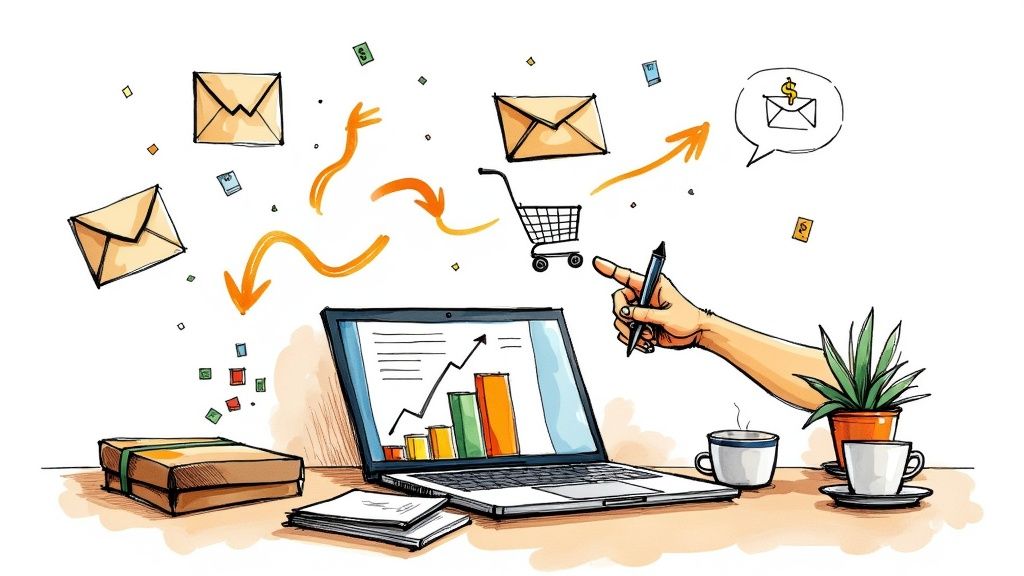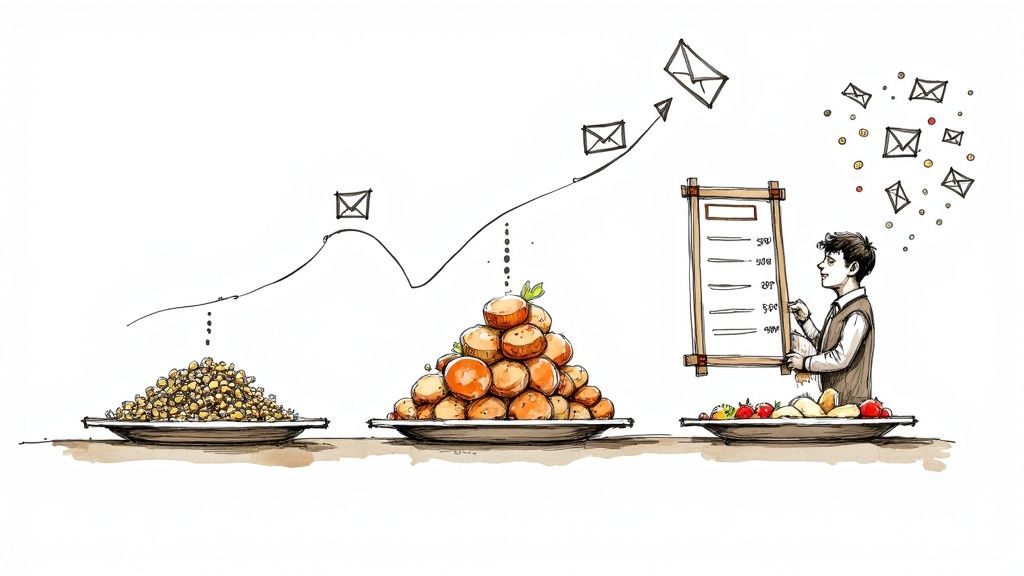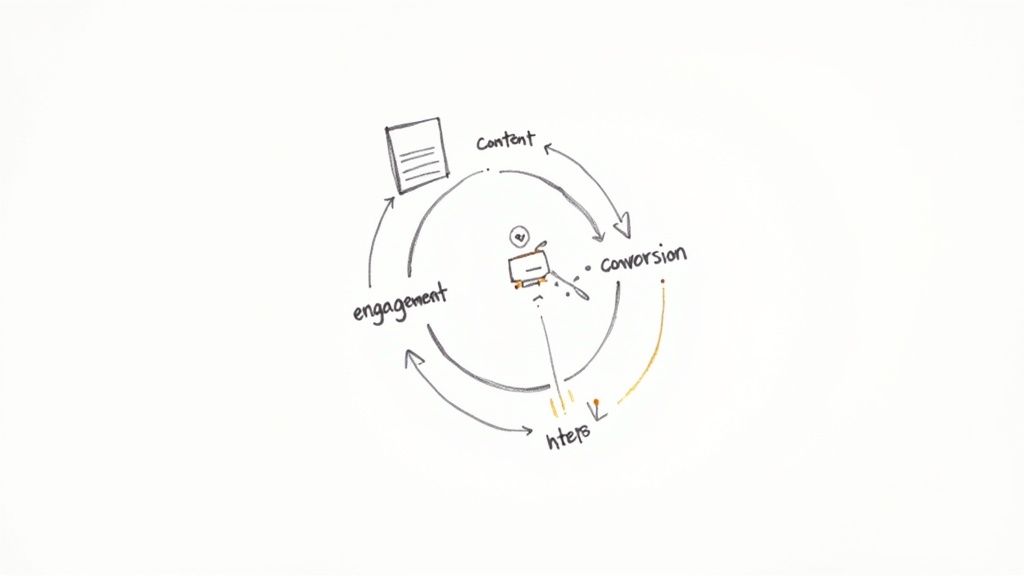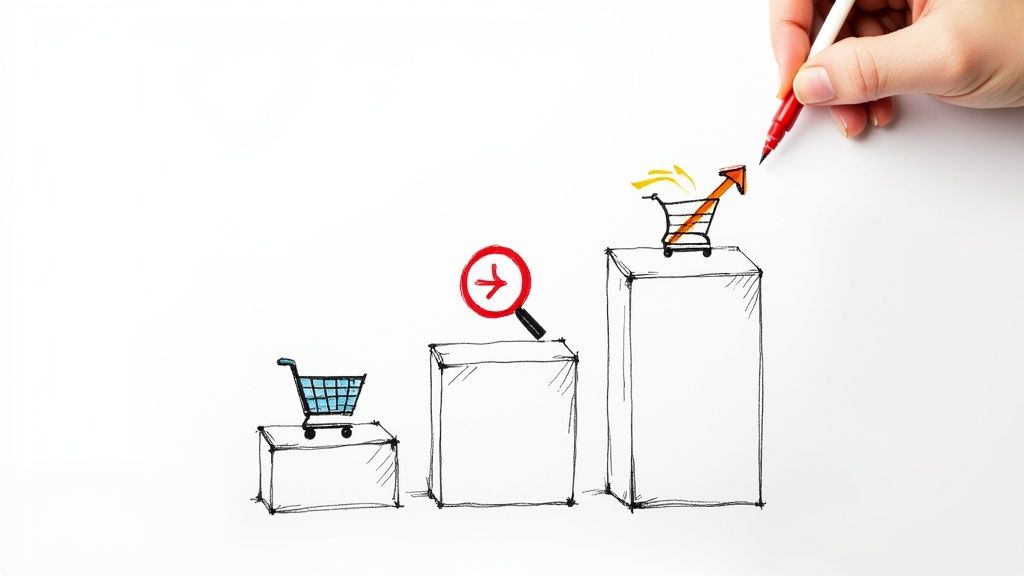Ecommerce Customer Segmentation That Drives Real Revenue

12 mins
6/15/2025
Joe Ervin
- ecommerce customer segmentation
- customer targeting
- ecommerce strategy
- email campaigns
- customer data
Why Most Stores Waste Money on Wrong Customers
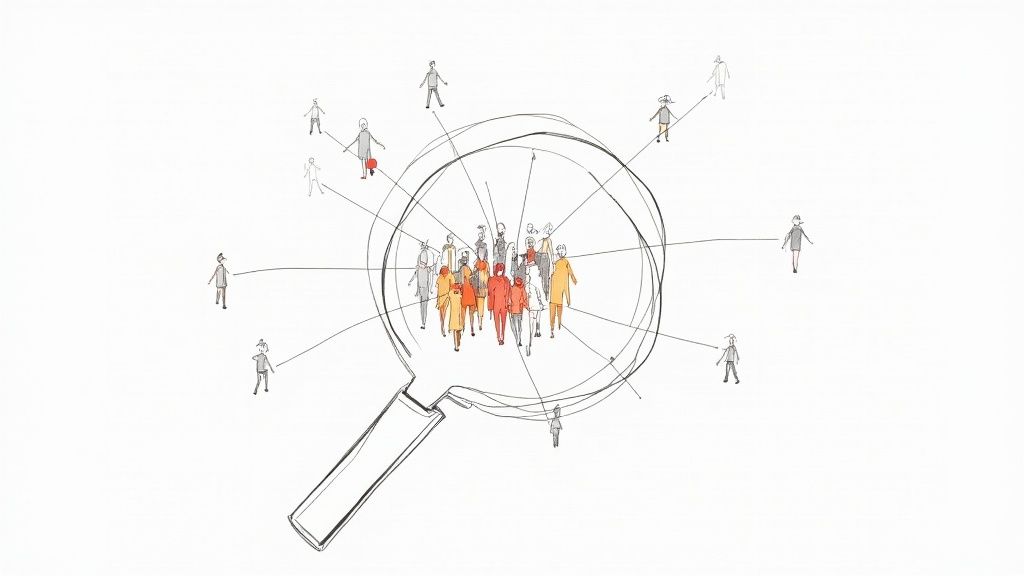
Lots of stores operate under the assumption that age and location are the keys to understanding customer buying habits. They're not. Blanketing everyone with the same email blasts is a recipe for wasted ad spend and annoyed customers. Imagine being bombarded with baby clothes ads when you haven't even thought about kids!
Savvy stores, on the other hand, pay attention to what customers do, not just their demographics. They use ecommerce customer segmentation. This boils down to grouping customers based on their actual shopping behavior. They might track which products are frequently bought together, for instance, or how often a customer comes back to shop.
These behavioral clues are way more powerful than age or location. A young person might have expensive tastes, while an older person might be a bargain hunter. And where someone lives becomes much less relevant when they're shopping online.
Truly successful stores focus on actions. They group customers based on purchase frequency, spending habits, and what they browse online. This approach transforms marketing from guesswork into a targeted strategy. Instead of throwing things at the wall and hoping something sticks, they know what their customers want. This saves money and builds customer satisfaction. Think about getting a discount on something you were already eyeing—that's the power of effective segmentation. And it's crucial to remember the sheer scale of online shopping. As of 2025, a whopping 85% of global consumers shop online. Over a third of them spent less than $200 online. With ecommerce sales projected to hit $7.4 trillion by 2025, you can see how vital good segmentation is. Discover more insights.
What Does Good Segmentation Look Like?
Here's how smart stores use ecommerce customer segmentation in the real world:
- Big Spenders: These are your VIPs. They get exclusive deals and early access to new products.
- Loyal Customers: These shoppers get rewarded for their repeat business—maybe a free gift or deeper discounts.
- New Customers: Stores roll out the welcome mat with emails showing them the ropes and highlighting popular items.
- Price-Sensitive Shoppers: These customers are all about the deals. They get coupons and alerts about sales.
Each group receives tailored messaging. A luxury shopper wants to see polished emails with beautiful imagery. A bargain hunter wants clear, concise information about savings. Smart stores get this, and it makes their marketing significantly more effective.
Hidden Goldmine in Your Store Data
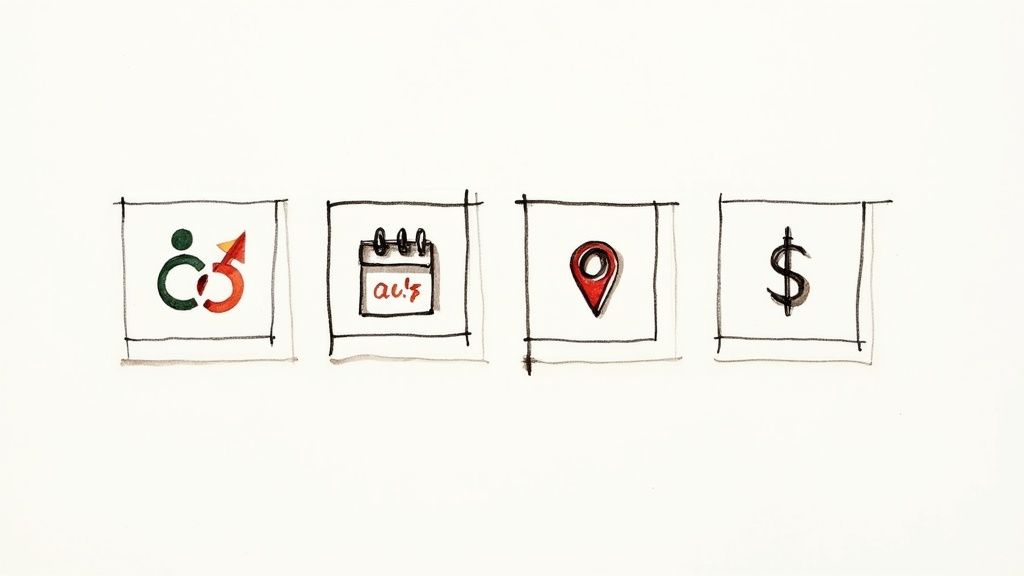
Your store data is a treasure trove of insights, but so many brands barely scratch the surface. They're looking at vanity metrics like page views, but the real gold lies in understanding your customers' behavior. It's like trying to understand a novel by just looking at the cover – you need to dive into the story. That's where ecommerce customer segmentation comes in – it's about reading the story told by your customers' actions.
Uncovering Customer Behavior Patterns
Forget the surface-level stuff. Look at how often a customer buys from you – their purchase frequency. This speaks volumes about their loyalty. Someone who buys weekly is a different customer than someone who buys every few months, and your emails should reflect that. You wouldn't send a "Welcome Back" email to your most loyal customer, right?
Abandoned carts are another goldmine. They tell you about price sensitivity and what might be causing hesitation. High shipping costs? Maybe they just got distracted. A friendly reminder email with a small discount can work wonders. Think of it as a gentle nudge at the checkout counter.
Reading Between the Lines
Even browsing history tells a story. The sequence of products a customer views reveals their interests. Someone browsing running shoes, then shorts, then hydration packs? They're probably gearing up for a run. These browsing sequences expose hidden patterns, allowing you to show them relevant ads or send them emails about upcoming sales on running gear.
The time between purchases is a powerful predictor of lifetime value. A weekly shopper is likely to spend more over time than someone who buys once a year. Knowing this helps you prioritize your marketing spend – nurture those relationships with high-potential customers!
What about searches on your site? These can reveal unmet needs and product gaps. If customers are searching for "blue widgets" and you only sell red, you're missing out. Use this information to guide product development and marketing strategies.
Returned items? They reveal satisfaction levels and potential product issues. High return rates for a specific item could signal a problem – inaccurate sizing, misleading descriptions, or even a quality issue. Addressing these problems builds trust and reduces future returns.
Finally, email engagement reveals communication preferences. Some customers open every email; others ignore most. Tailor your email frequency and content accordingly. Don't bombard someone with emails if they rarely open them.
To help illustrate the types of data you can use, take a look at the table below:
Essential Customer Data Points for Segmentation
Key behavioral and transactional data elements that create effective customer segments
| Data Point | Segmentation Value | Collection Method | Action Trigger |
|---|---|---|---|
| Purchase Frequency | Loyal vs. Occasional Shoppers | Transactional Data | Targeted Promotions, Loyalty Programs |
| Abandoned Cart Items | Price Sensitivity, Hesitation Factors | Behavioral Data | Reminder Emails, Discount Offers |
| Browsing Sequence | Product Interest, Purchase Intent | Behavioral Data | Targeted Ads, Product Recommendations |
| Time Between Purchases | Lifetime Value Prediction | Transactional Data | Personalized Marketing, Retention Strategies |
| Search Queries | Unmet Needs, Product Gaps | Behavioral Data | Product Development, Targeted Campaigns |
| Returned Items | Satisfaction Levels, Product Issues | Transactional Data | Quality Control, Customer Service Improvements |
| Email Engagement | Communication Preferences | Behavioral Data | Email Frequency and Content Optimization |
This table summarizes the crucial data points you need to collect and how they can be used to power your email marketing segmentation.
By using all this data, you're creating detailed portraits of your customers. You're transforming random actions into predictable patterns. Maybe you discover Monday shoppers spend more. Or that mobile users prefer shorter emails. This level of detail fuels truly targeted and effective email campaigns. That’s how you turn data into dollars.
Building Segments That Make Money

I've seen so many stores get bogged down creating tons of tiny customer segments, obsessing over details that don't actually move the needle. They end up with 20 micro-groups and a headache. Trust me, managing all those segments costs more than it earns. Savvy stores, the ones really making bank, focus on profit potential from the get-go. Forget starting with generic customer characteristics. Start with who's spending the big bucks.
Focusing on High-Value Customers
Think of it like a VIP club. Your highest spenders? They get the red carpet treatment. Your frequent buyers? Reward their loyalty with something special, maybe a surprise discount. Those one-time wonders? Craft emails to woo them back. This, my friend, is ecommerce customer segmentation that actually makes sense.
Now, a word about segment size. Each segment needs enough customers to justify the effort of personalized emails. A group of 50? That's like trying to fill a pool with a teaspoon. 5,000? Now you’re talking! That's a proper swimming pool, not a puddle. The sweet spot is balancing segment size with the personal touch of your messages. Think Goldilocks – not too big, not too small, just right.
Combining Behaviors for Actionable Insights
The real magic happens when you combine customer behaviors to predict similar buying habits. Think about it: someone filling their cart with designer shoes tells you something. They're likely not browsing for bargain-basement deals. On the flip side, someone who only buys during sales tells you something entirely different. They're your price-sensitive shoppers.
By combining these actions, you create targeted groups that respond to your emails like gangbusters. Imagine getting an email about a sale on the exact shoes you were eyeing. That's the power of combining behaviors. Your goal? Segments that trigger specific, profitable actions. You want customers to do something – buy a product, subscribe to your newsletter, tell their friends.
Examples of Profitable Segments
Here’s a glimpse at some high-performing segments I’ve seen in action:
- VIPs: Big spenders, frequent buyers. Give them exclusive early access and premium offers.
- Loyal Customers: They keep coming back for more! Reward them with loyalty programs and special perks.
- Potential Loyalists: A few purchases under their belt. Nudge them towards larger orders and more frequent visits.
- Price-Sensitive Shoppers: Deal hunters extraordinaire. Send them coupons and sale alerts.
- Abandoned Cart Shoppers: So close! Remind them what they left behind and sweeten the deal with a small incentive.
To help illustrate this further, let’s look at some proven segments:
High-Impact Customer Segment Types Proven customer segments that drive the highest ROI for ecommerce businesses
| Segment Type | Key Characteristics | Email Strategy | Expected Revenue Impact |
|---|---|---|---|
| VIPs | High average order value, frequent purchases | Exclusive previews, early access to sales, personalized recommendations | Highest revenue potential |
| Loyal Customers | Repeat purchases, consistent engagement | Loyalty program updates, exclusive discounts, birthday rewards | Significant revenue contribution |
| Potential Loyalists | Made 2-3 purchases, moderate engagement | Personalized product recommendations, targeted promotions, welcome series | Increased average order value and purchase frequency |
| Price-Sensitive Shoppers | Responds to discounts and promotions, actively looks for deals | Coupon codes, sale alerts, price-drop notifications | Boosts sales during promotional periods |
| Abandoned Cart Shoppers | Added items to cart but didn't complete purchase | Cart reminders, limited-time discounts, free shipping offers | Recovers lost sales |
This table breaks down the core characteristics of each segment, suggests tailored email strategies, and highlights the expected impact on your bottom line. Focusing on these segments can really supercharge your email marketing efforts.
Remember, the whole point of ecommerce customer segmentation is to boost your revenue. Choose segments that align with that goal. Focus on actions, not just descriptions.
Email Campaigns That Customers Actually Want
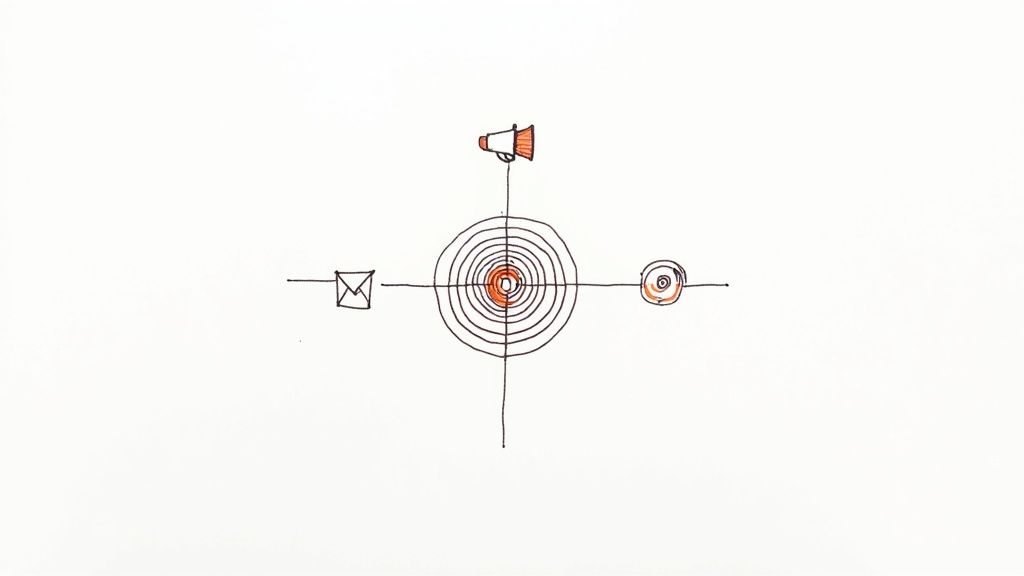
Let's be honest, generic email blasts are a bit like shouting into a void. Sure, a few people might hear you, but most are just tuning it out. That's where ecommerce customer segmentation comes in. Think of it as switching from a megaphone to a personal conversation.
Segmented emails feel relevant and tailored to the individual, making it way more likely someone will actually open, read, and (most importantly) click that "buy" button.
Your customers are all different. Your VIPs might want exclusive sneak peeks at new products. Your bargain hunters are probably scouring for discount codes. Repeat buyers love a good loyalty program. And your brand new customers? They need a warm welcome. One-size-fits-all messaging just doesn't cut it. In fact, you risk alienating some of your most valuable customers. Imagine sending a discount code to a VIP who never uses them – it can actually diminish their perceived value. For more on keeping your customers happy, check out our guide on ecommerce customer retention.
Matching Message to Segment
Different segments have different priorities. Luxury shoppers often respond to sleek, minimalist emails with beautiful imagery. Bargain hunters? Bold text and clear savings are key.
Getting this right can significantly impact your results. Think open rates jumping from 15% to 35%, or click rates doubling, even tripling. And the best part? A noticeable boost to your bottom line.
Format and Timing: Two Critical Pieces
Even seemingly small details like email format and timing play a big role. Mobile users need short subject lines and layouts that are easy to scan. Desktop users can handle more complex designs and information.
Thinking about when your customers are most likely to engage is also crucial. Business professionals might be checking email during office hours. Parents might be shopping online after the kids are tucked in. Students are likely browsing on weekends. Aligning your message, format, and timing with the right segment makes all the difference.
Examples of Segmented Email Success
Picture this: A new customer gets a welcome email with a discount code. A loyal customer receives a thank you email with bonus reward points. A VIP gets early access to a new product line. This is ecommerce customer segmentation in action.
Here are a few more practical examples:
- New Customers: "Welcome! Here's a discount on your first order."
- Repeat Customers: "Thanks for your loyalty! Here's a bonus reward."
- VIP Customers: "Get exclusive early access to our new collection!"
- Price-Sensitive Customers: "Sale Alert! Get 20% off this weekend!"
- Abandoned Cart Customers: "Did you forget something? Finish your purchase now!"
These targeted emails feel personal, not like generic spam. This fosters trust and loyalty, leading to more sales and happier customers. It's a win-win for everyone.
Testing and Fixing Broken Segments
Even the best ecommerce customer segmentation strategies need a regular tune-up. Just like your car, you can't just set it and forget it. Customer behavior changes constantly. What resonated with shoppers last year might totally flop this year. Savvy brands understand this and constantly monitor how their segments are performing. They're watching key metrics like revenue generated per customer within each segment, email open rates, and how many clicks actually turn into sales.
Spotting Trouble Early
The most successful brands are like detectives – they’re pros at spotting warning signs early on. Perhaps sales in a particular segment have taken a nosedive. Or maybe fewer people are even bothering to open their emails. These are clear indicators that something needs adjusting. Think of it like hearing a strange noise coming from your car’s engine - you wouldn’t wait until it breaks down on the highway to get it checked out. The same principle applies to your customer segments.
Sometimes the solution is simple, a quick fix like rewriting your email subject lines. Other times, the issue runs deeper, requiring a complete overhaul of how you define a specific segment. Maybe your target audience has shifted their buying habits, or a competitor has entered the market and changed the game. Perhaps your own products have evolved, making your old segments obsolete. Investigating the root cause is crucial. For a deeper dive into optimizing your email strategy, check out: our guide on effective email flows.
Testing and Experimentation
When a segment underperforms, testing is your best friend. It's all about experimentation, like a scientist in a lab. Try different approaches and see what sticks. You might divide a segment in half and test different email messaging on each group. Or experiment with sending emails at various times of the day. Perhaps a different kind of discount will be more enticing. The key is to consistently track your results. Which emails get opened more? What's actually driving sales? Double down on the winners and dissect the losers. Remember, even the tests that don't go as planned offer valuable insights. They reveal what doesn't resonate with your audience, which is just as important as knowing what does.
Constant Optimization
This ongoing process of testing and tweaking is what keeps your segments healthy and generating revenue. Imagine tending a garden. You consistently remove weeds (your underperforming segments) to allow the healthy plants (your profitable segments) to flourish. This constant optimization is essential for staying competitive and profitable in a market that's always evolving. It’s the difference between a thriving business and one that’s constantly playing catch-up.
Tools That Actually Work for Your Business
Picking the right tools for ecommerce customer segmentation is like finding the perfect pair of shoes. Think about it: a marathon runner needs something different than someone strolling through the park. The same logic applies to your business. A small online store doesn't need complex enterprise software, just like someone new to running doesn't need the most expensive shoes out there. Larger companies, however, can quickly outgrow basic tools – it's like trying to run a marathon in flip-flops! You absolutely need the right fit.
Email and Analytics Platforms
For ecommerce, email platforms like Klaviyo are invaluable. They connect directly to your store's data, making customer segmentation and automated campaigns a breeze. This allows you to send the right message to the right person, automatically. Think welcome emails for new subscribers or special offers for your VIP customers – all on autopilot.
Klaviyo's ecommerce focus makes segmenting customers and building targeted email flows incredibly simple. This direct integration saves you time and effort, letting you focus on creating truly effective messages.
Then there are analytics tools like Google Analytics. They're like detectives, uncovering hidden patterns in how customers behave on your site. This data can reveal which segments are performing well and where you have room for improvement. For example, you might discover that mobile shoppers add more items to their carts, but desktop users have a higher average order value. These insights can inform everything from your website layout to your email design.
Customer Data Platforms and Scaling Up
As your business expands, consider a Customer Data Platform (CDP) like Segment. CDPs are like a central hub, bringing together all your customer data from various sources – your website, email marketing, social media, and more. This creates a complete picture of each customer, allowing for truly personalized messaging.
Growth requires tools that can scale with you. Look for tools that can handle large amounts of data and offer custom integrations through APIs. And don't underestimate the value of good customer support – sometimes, you just need a helping hand.
For more on building the ideal tech stack for your business, check out our guide on building your perfect ecommerce technology stack. Remember, price is a factor, but the real key is value. A tool that doubles your email revenue quickly pays for itself. Don't limit your growth by sticking with free tools that can't keep up. Investing in tools that scale may actually save you money down the line.
Your 30-Day Segmentation Action Plan
Knowledge is power, but action brings home the bacon. This plan helps you turn customer insights into increased sales in just 30 days. It's your practical guide to getting real results from ecommerce customer segmentation.
Week 1: Getting to Know You
The first week is about getting organized. Dive into your customer data. Who are your rockstar customers? Who's buying up a storm and coming back for more? Identify those VIPs! Then, create three simple groups based on their purchasing habits. Maybe one group is all about shoes, another is obsessed with accessories, and a third only shops during sales.
Week 2: Building Your Email Engine
Week two is about building the engine that fuels your email marketing. Set up tools like Klaviyo or Iterable to track customer behavior. Your chosen email platform should allow you to create the groups you defined in week one. Start crafting unique emails for each group. What makes them tick? Shoe lovers might appreciate new arrivals, while bargain hunters are all about the sales.
Week 3: Hitting "Send"
It's go time! Launch your targeted emails and monitor the results. What's the open rate? Are people clicking those links? Most importantly, how are these emails impacting your bottom line? These numbers are your compass, showing you what's resonating with your audience.
Week 4: Fine-Tuning for Success
The final week is about making good things even better. Analyze the results from week three. Which emails performed like a charm? Which ones fell flat? Double down on what worked, tweak what didn't, and plan your next email campaign. This constant optimization is key to maximizing ecommerce customer segmentation and keeps your email marketing fresh, relevant, and profitable.
